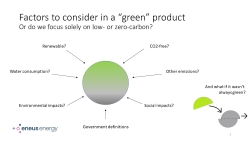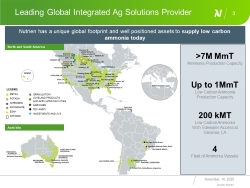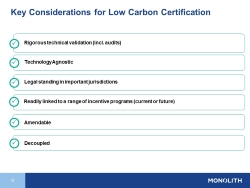Certification of low-carbon ammonia: panel wrap-up from the 2020 Ammonia Energy Conference
By Julian Atchison on January 28, 2021
What are the key considerations that need to be worked through so we can design and implement a certification scheme for low-carbon ammonia that works for a diverse range of stakeholders?
On November 17, 2020, the Ammonia Energy Association (AEA) hosted a panel discussion moderated by Jonathan Lewis from the Clean Air Task Force, as well as panel members Blake Adair from Nutrien, Tobias Birwe from thyssenkrupp, Rob Hanson from Monolith Materials, and Krista Mann from Eneus Energy as part of the recent Ammonia Energy Conference.
Not only was it valuable to find out what important players in the ammonia industry want to see in any future certification scheme, but the panel also kicked off a consultation process among AEA members. An audience of around one hundred and fifty producers, end users and researchers all gave their thoughts on what they would like to see in a future scheme, providing a terrific launching point for the AEA Certification Committee to draft, develop and debut a low-carbon ammonia certification scheme.
What does “green ammonia” actually mean?

Krista Mann raised the important point that the term “green” can be used interchangeably with the terms clean, renewable, alternative, low-carbon, low-emissions and even environmentally-friendly. All of these terms are similar, but each has its own connotations and implicit assumptions. What details, other than carbon intensity, do stakeholders want to know about a “green” product? All greenhouse gas (GHG) emissions measured as carbon dioxide equivalent (CO2e), and not just CO2? Water consumption? Other environmental and social impacts? Was the product always green? Government and regulatory requirements?
As ammonia is a truly global product, that last detail is critical. Can a single certification scheme be designed to work across geopolitical situations and get different countries all agreeing on the same set of principles?
And, although the current vernacular of colors for ammonia is widely acknowledged to be over-simplified (possibly even misleading) it’s an easy structure to communicate and resonates with stakeholders outside the ammonia community. Any successful certification scheme will be widely taken up by people unfamiliar with the industry. Simplicity, ease of communication, and making sure that regulatory requirements are not overly burdensome are all musts. All panelists strongly agreed on this point.

Another crucial step will be leveraging current assets, infrastructure, regulations, and certification work currently going on in the hydrogen world (eg. the CertifHy scheme in the EU).
And how do we ensure the environmental and/or carbon credentials of ammonia molecules remain the same at all points in a complicated production, storage and transport system? Should we account for different modes of ammonia transport and the emissions they entail? AEA Certification Committee chair Blake Adair then raised the important point that any new scheme should take advantage of current GHG inventory, reporting, and auditing requirements.

As to what auditing may look like in practice, there was broad agreement from the panelists that real-time and daily emissions tracking would be too onerous – weekly or monthly emissions inventories for an ammonia certification scheme would probably be the desired outcome. Moderator Jonathan Lewis, who leads the Regulatory working group that stems off the Certification Committee, certainly anticipates the AEA scheme will include a lot of overlap and integration with what’s currently in place. As for the hydrogen world, Rob Hanson believes we should be open minded and “shamelessly willing” to draft our work off theirs. After all, the carbon intensity of the hydrogen used to produce ammonia is the biggest contributor to the ammonia’s overall carbon footprint.
What emissions should be included in GHG intensity calculations?

When the panel asked the audience which emissions they believed should be included in GHG intensity calculations, almost two-thirds of the attendees answered that Scope 1, 2, and 3 emissions should all be counted.
This resulted in an interesting discussion among the panelists. Blake Adair and Tobias Birwe both pointed out that Scope 3 calculations are complex, especially as the legal definitions of Scope 3 emissions can change between jurisdictions. For Tobias, if companies just got their Scope 1 and 2 calculations and compliance systems right, that would be a much more complete emissions overview than we think. Tobias was also keen to stress the importance of consensus and cooperation between governments as a path forward, acknowledging the reality that a lot of legal decisions on energy and transition are being made in politically-charged atmospheres (Scope 3 emissions could thus create a thorny issue between parties).
As a counterpoint, Rob Hanson reminded us that ammonia could end up being an energy vector for 20% of the global energy system, so the stakes are high and we have to get this as right as possible – especially when it comes to emissions regulation. The endgame of decarbonisation is to reduce and ultimately reverse the impacts of climate change, so let’s ensure we build a system that actually achieves this.
What really counts: carbon intensity
Having representatives from leading ammonia and chemical producers on the panel helped demonstrate that any certification scheme needs to be applicable to a diverse set of production pathways and technologies – some of which may be the last thing people think of when they hear “green ammonia”! We need to stay technology agnostic and focus on what really counts: the carbon intensity (CO2e) and climate change potential of the product. This applies equally to Nutrien’s use of carbon dioxide by-product for sequestration or utilization in enhanced oil recovery (EOR) and urea production, or to thyssenkrupp’s Carbon2Chem initiative where industrial off-gases are captured and utilised, or to Monolith’s methane pyrolysis technique where elevated temperatures and pressures split methane into hydrogen and solid, useable carbon. The decarbonisation and de-risking of formerly carbon-intensive industrial processes and facilities is necessary for companies to meet their ambitious emission reductions targets. Not only should future certification schemes include incentives to help first movers, but they should recognise the potential of different technologies to displace and reduce emissions. For example, Monolith’s process, which also produces solid carbon, has the potential to replace today’s emissions-intensive manufacturing process for Carbon Black (which makes up a third of all tires across the globe and for which 2.3 tonnes of CO2 is emitted for every tonne produced).
So, although it appears the panel session produced more questions than definitive answers, there was broad agreement on the fundamentals.
Any future certification scheme should:
- Be easy to use and accessible for new users;
- Be easily communicable to unfamiliar parties, with good vernacular;
- Let analysis and calculations determine carbon intensity of the product, and avoid assumptions that exclude certain technologies and pathways;
- Harmonize with existing schemes and schemes in development;
- Have shelf-lives and boundaries to make sure emissions are properly accounted for, so that environmental benefits are not double-counted;
- Be able to trade ammonia as a molecule and a certificate/credit, so that parties who wouldn’t normally be able to obtain the molecular product can still invest in the environmental attributes;
- Be a result of wide consultation from a diverse range of stakeholders.
There will be opportunities for AEA members and other stakeholders to get involved in developing and demonstrating this certification scheme, and to provide input during the consultation process as the Certification Committee pushes forward.
If you wish to view the archived video of the ammonia certification panel discussion, please register for the conference to access all session recordings. You can also browse and download all of the Ammonia Energy Conference 2020 presentations.